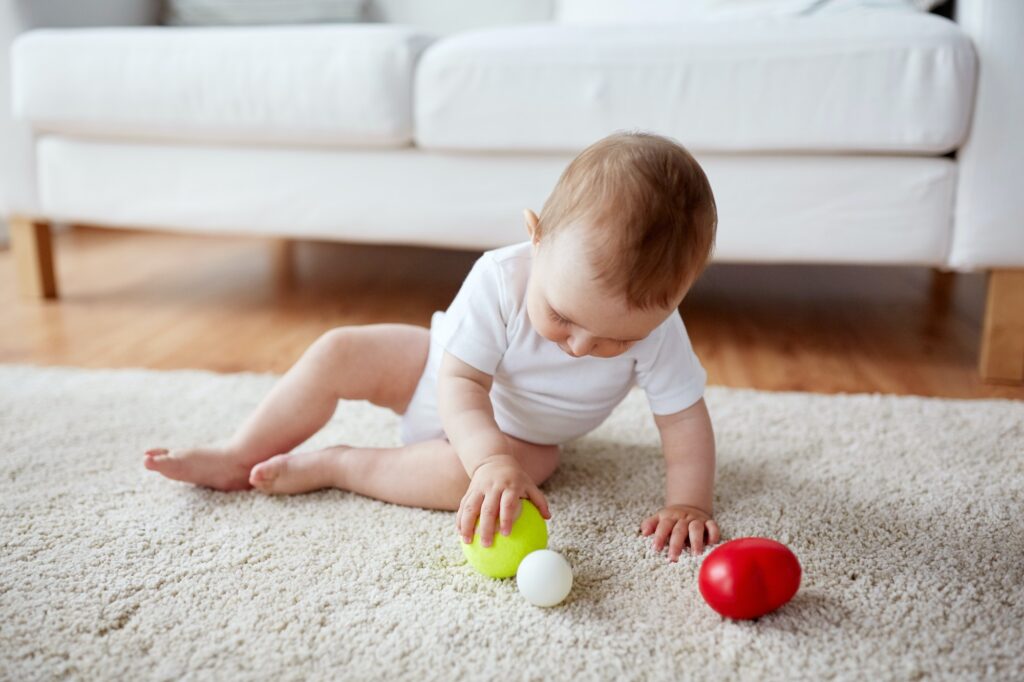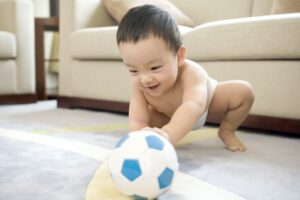
Cerebral Palsy: Infant Motor Skill Development
Cerebral Palsy: Infant Motor Skill Development A diagnosis of Cerebral Palsy can feel overwhelming for parents. By gaining an understanding of Cerebral Palsy infant symptoms

A diagnosis of Cerebral Palsy can feel overwhelming for parents. By gaining an understanding of Cerebral Palsy infant symptoms and normal development, you can help your baby to reach their full potential to live a thriving life.
Cerebral Palsy infant motor skill development is critical for building a foundation for progression in all areas of life. This includes fine motor play, speech, cognition, social development and more.
The severity of Cerebral Palsy varies from very mild to quite severe. There are a range of symptoms affecting each child in a different way. Regardless of severity, your baby may benefit from intensive intervention as soon as possible to unlock true potential for motor skill development.
According to the Cerebral Palsy Alliance, “Neuroscience research demonstrates early intervention including intensive, repetitive, task-specific exercise should commence for children diagnosed with Cerebral Palsy within the first 12 months of life to optimize neuroplasticity.” See the link to the Cerebral Palsy Alliance at the end of this article for excellent information about early diagnosis and treatment.
Cerebral Palsy affects the way a baby moves.
You may notice jerky body movements or trouble with moving against gravity. Some babies with Cerebral Palsy appear very floppy and others seem to have very tight or rigid bodies. Your baby might have weakness on the right or left side of the body. Or symptoms could affect the upper extremities, lower extremities, or the entire body.
Cerebral Palsy symptoms interfere with developing motor milestones. Here are a few examples of motor milestones which may be difficult due to weakness, muscle tone problems, and motor control. This list is not for diagnosing Cerebral Palsy. Rather, it provides information for parents to discuss with their pediatrician or physical therapist.
Difficulty with Motor Milestones | Typical Age |
Source: Evidence-Informed Milestones for Developmental Surveillance Tools by Zubler and colleagues (referenced below) | |
Difficulty looking at your face, watching you move, or looking at a toy | By 2 months |
Difficulty holding head up when on tummy (floppy head) | By 2 months |
Difficulty moving both arms and legs (movements appear weak or favor one side) | By 2 months |
Difficulty holding head steady without support when you hold baby upright | By 4 months |
Difficulty pushing up onto both elbows or forearms when on tummy | By 4 months |
Difficulty turning head towards the sound of your voice | By 4 months |
Difficulty reaching to grab a toy | By 6 months |
Difficulty pushing up with straight arms on tummy | By 6 months |
Difficulty leaning on both hands to sit | By 6 months |
Difficulty sitting without support | By 9 months |
Parents need high quality resources to fully understand important motor milestones as well as for all areas of development. Pathways is a nonprofit organization with the goal to “Ensure every child is screened for motor, sensory, and communication development by 4 months of age, taking advantage of baby’s neuroplasticity.” See the link to Pathways at the end of this article to access free resources and a video with side-by-side comparison of 4-month-old babies with typical and atypical motor development.
An understanding of symptoms helps with targeting interventions to improve motor skills. It’s important to address the underlying problems with evidence-based treatments and interventions as soon as possible.
In the past, parents received advice to “wait and see” before pursuing intervention and even diagnosis. Now, organizations including the Center for Disease Control and Prevention and the American Academy of Pediatrics discourage this approach. Instead, there is much support for early diagnosis and early treatment when the brain is developing at a rapid pace (1.)

There is lots you can do!
Your baby needs lots of practice to develop skills and alleviate symptoms of Cerebral Palsy. While there are many available treatments, know there are few studies specifically on babies and toddlers with Cerebral Palsy. This can make it difficult to find the right treatment.
According to an article published by The American Academy for Cerebral Palsy and Developmental Medicine (2), current best evidence supports activity-based interventions which encourage child-initiated movements, task specific training and stimulating environments.
This means your child needs to actively practice skills such as rolling, sitting, and playing rather than passively receiving treatments such as stretches.
Try offering toys from different angles and adjust the position to encourage active reaching. Move it closer or to one side or the other. Observe your baby to look for strengths. Provide toys that are easy for your child to grasp.
Babies may be more motivated by toys with lights or music for sensory stimulation. Other babies with Cerebral Palsy may benefit from highly familiar toys with single bright colors, especially if your baby has a secondary diagnosis of Cortical/Cerebral Visual Impairment.
Make sure to provide wait time when offering toys for exploration. Your baby might surprise you when he or she has some extra time to process and make attempts.
Take your baby with you to explore nature, the grocery store, and other sights and sounds to spark curiosity for movement. Your baby needs a stimulating environment!
Be aware that prolonged positioning in car seats, infant seats or other baby devices could interfere with practicing much needed skills.
If you find it difficult to help your child, you are not alone. Cerebral Palsy infant care is highly specialized. You will benefit from collaborating with a skilled physical therapist, occupational therapist, speech therapist, physician, or other professional with deep knowledge about Cerebral Palsy.
Here’s an example of specialized programming for infants and toddlers with Cerebral Palsy: Thrive Sweet Baby Program – Cerebral Palsy Intensive Therapy
Cerebral Palsy infant care can be challenging, but also rewarding when you see your baby making progress. Remember to start intervention right away to maximize the benefits of neuroplasticity!
There is a lot of information available on the internet! It’s important to use trusted sources to help your baby.
Cerebral Palsy Alliance: Early Diagnosis Clinic – Cerebral Palsy – Cerebral Palsy Alliance
Pathways Resources: Help Your Child Reach Their Full Potential | Free Resources (pathways.org)
Pathways Video of 4-month-old babies: 4 Month Old Typical and Atypical Motor Development (pathways.org)
Consider Thrive Sweet Physical Therapy and Wellness in Northeast Ohio. Dr. Sweet will consider traveling to any location in the State of Ohio. Call 440-525-2792 or check out www.thrivesweet.com for more information.
Zubler JM, Wiggins LD, Macias MM, Whitaker TM, Shaw JS, Squires JK, Pajek JA, Wolf RB, Slaughter KS, Broughton AS, Gerndt KL, Mlodoch BJ, Lipkin PH. Evidence-Informed Milestones for Developmental Surveillance Tools. Pediatrics. 2022 Mar 1;149(3):e2021052138. doi: 10.1542/peds.2021-052138. PMID: 35132439; PMCID: PMC9680195.
Noritz G, Davidson L, Steingass K; Council on Children with Disabilities, THE AMERICAN ACADEMY FOR CEREBRAL PALSY AND DEVELOPMENTAL MEDICINE; Providing a Primary Care Medical Home for Children and Youth With Cerebral Palsy. Pediatrics. 2022 Nov 21:e2022060055. doi: 10.1542/peds.2022-060055. Epub ahead of print. PMID: 36404756.

Cerebral Palsy: Infant Motor Skill Development A diagnosis of Cerebral Palsy can feel overwhelming for parents. By gaining an understanding of Cerebral Palsy infant symptoms

Facebook Linkedin Youtube Instagram HERE ARE THE 5 BEST TIPS FOR PARENTS OF BABIES WITH CEREBRAL PALSY IN 2023 With so much information on the
This blog is for general informational and entertainment purposes only and any use of this information is at the user’s own risk. This blog does not constitute the practice of medicine, professional health care services, the giving of medical advice, diagnosis, treatment, or any other medical service. While this content writer is a Physical Therapist, she is not your physical therapist, and no patient/client relationship is formed by reading this blog. Blog content on this website is not intended to be a substitute for professional medical advice, diagnosis, or treatment. Users should not delay in seeking medical advice for any concerns about medical conditions.
This website may contain “affiliate links” within website pages or blog posts. We assume no responsibility for errors or omissions caused by other websites that may be included our written materials. We have no control over the contents or functionality of those affiliate websites and so we accept no responsibility for any loss, damage, or otherwise that may arise from your use of them and therefore we do not guarantee the accuracy, completeness, or usefulness of any other website or their content. It is your responsibility to review the terms and conditions and privacy policies of those linked websites to confirm that you understand and agree with those policies.
Please note that by purchasing an item through an affiliate link, Thrive Sweet Physical Therapy & Wellness receives a small commission. While purchase through our website does not constitute warranty or produce guarantee, we share only familiar products and services we personally use. You understand that you are not obligated to purchase these items, and can purchase items from any source of your choosing. You understand that the services you are offered will not be affected if you choose to purchase similar items elsewhere.